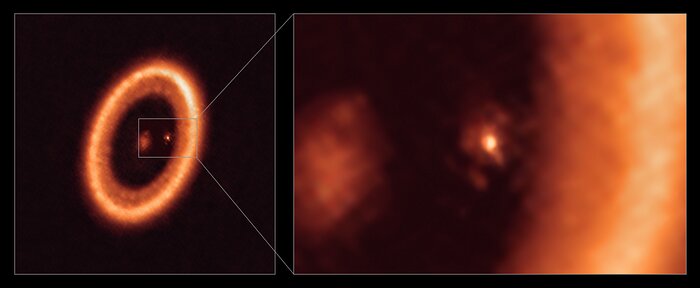With the help of the Atacama Large Millimeter/submillimeter Array (ALMA), in which the European Southern Observatory (ESO) is a partner, astronomers have clearly detected for the first time the presence of a disk around an outside planet. of our Solar System. These observations give us new clues about how moons and planets form in young star systems.
“Our work shows clear detection of a disk where satellites may be forming,” said Myriam Benisty, a researcher at the University of Grenoble, France, and the University of Chile, who led this new work published on July 22, 2021 in The Astrophysical Journal Letters. "These observations were obtained by the ALMA and they have such resolution that we could clearly identify that the disk is associated with the planet and we were also, for the first time, able to get limits on its size,” he adds.
The disk in question, called the circumplanetary disk, surrounds the exoplanet PDS 70c, one of two Jupiter-like giant planets orbiting a star nearly 400 light-years away from Earth. astronomers already had previously discovered clues of the existence of a moon-forming disk around this exoplanet, but since they could not separate the disk from the surrounding medium, it had not been possible to confirm its presence so far.
Additionally, with the help of ALMA, Benisty and his team discovered that the diameter of the disk has an approximate size corresponding to the Earth-Sun distance and enough mass to form up to three satellites the size of our Moon.
These results aren't just crucial to figuring out how moons form. "These new observations are also extremely important to support theories of planetary formation that, until now, we have not been able to test," explains Jaehan Bae, a researcher at the Earth and Planets Laboratory of the Carnegie Institution for Science, USA, and one of the authors of this study.
Planets form into dust disks around young stars, carving out cavities as they “swallow” material from the circumstellar disk to grow. During this process, a planet can acquire its own circumplanetary disk, which contributes to the planet's growth by regulating the amount of matter that is attracted to it. At the same time, gas and dust from the circumplanetary disk can assemble into progressively larger bodies through multiple collisions, ultimately leading to the birth of moons in orbit around these planets.
However, astronomers still do not understand these processes very well. “In short, it is not yet clear when, where and how planets and their moons form,” says Stefano Facchini, an ESO fellow, who is also involved in this research work.
“So far more than 4000 exoplanets have been discovered, but they are all part of mature systems. PDS 70b and PDS 70c, which form a system reminiscent of the Jupiter-Saturn pair, are the only two exoplanets detected so far that are still in the process of formation,” explains Miriam Keppler, researcher at the Max Planck Institute for Astronomy, Germany, and one of the co-authors of this study.
“This system therefore offers us a unique opportunity to observe and study the formation processes of planets and satellites,” adds Facchini.
PDS 70b and PDS 70c, the two planets that make up the system, were initially discovered with the help of the Very Large Telescope (VLT) of ESO in 2018 and 2019, respectively, and their unique nature means that they have been observed later and several times by other telescopes and instruments.
These high-resolution observations from ALMA have now allowed astronomers to find out more about this system. In addition to confirming the presence of a circumplanetary disk around PDS 70c and estimating its size and mass, the researchers also found that PDS 70b does not show clear evidence of such a disk, indicating that its birthplace must being dust-free due to his companion, PDS 70c.
With Extremely Large Telescope (ELT) of ESO, which is being built at Cerro Armazones in the Chilean Atacama Desert, we will be able to understand even better this planetary system. “The ELT will be crucial to this research work as, with its even higher resolution, we will be able to map the system in great detail,” says co-author Richard Teague, researcher at the Center for Astrophysics | Harvard & Smithsonian, USA. In particular, using the instrument METIS (Mid-infrared ELT Imager and Spectrograph) that will be mounted on the ELT, the team will be able to see the movements of the gas that surrounds PDS 70c, thus obtaining a three-dimensional view of the system.





















Comments